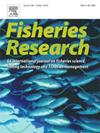Polychaete bait fisheries in Galicia (NW Spain)
IF 2.2
2区 农林科学
Q2 FISHERIES
引用次数: 0
Abstract
In Galicia (NW Spain) commercial polychaete fisheries have increased their importance compared to other traditional fisheries in recent years, both in terms of catches and economic benefits. We performed a systematic review of scientific literature to analyze the main attributes and the impacts of polychaete fisheries. Official landings statistics in Galicia showed that Scoletoma laurentiana, Diopatra neapolitana, Arenicola marina, and Hediste diversicolor are the species that are sold as bait for recreational fisheries. By an online survey of recreational fishers, we found that 17 % of them collect their own polychaetes, while the majority also buy them with very different frequencies. We estimated that recreational harvest is roughly eight times higher than commercial harvest for some species. Interviews with various stakeholders, including scientists, managers, commercial harvesters, recreational fishers, and sellers, revealed both positive and negative aspects of polychaete fisheries. Challenges include the lack of biological and ecological studies on exploited species and the necessity for reliable stock assessment methods, including the need for weight conversion factors for key species. Additionally, more information on the local and imported polychaete value chains is crucial. Addressing these issues will contribute to the development of more sustainable polychaete harvesting, benefiting both the environment and local and global economies.
加利西亚(西班牙西北部)多毛类鱼饵渔业
在加利西亚(西班牙西北部),与其他传统渔业相比,商业多毛类渔业近年来在捕获量和经济效益方面的重要性都有所提高。我们对科学文献进行了系统的回顾,分析了多毛类渔业的主要属性及其影响。加利西亚的官方登陆统计数据显示,laurentiana, Diopatra neapolitana, Arenicola marina和Hediste diversicolor是作为休闲渔业诱饵出售的物种。通过对休闲渔民的在线调查,我们发现17% %的人自己收集多毛鱼,而大多数人也会以非常不同的频率购买多毛鱼。我们估计,对某些物种来说,休闲捕捞量大约是商业捕捞量的8倍。采访了包括科学家、管理人员、商业捕捞者、休闲渔民和销售商在内的各种利益相关者,揭示了多毛类渔业的积极和消极方面。挑战包括缺乏对被开发物种的生物学和生态学研究,需要可靠的种群评估方法,包括需要关键物种的权重转换因子。此外,关于本地和进口多毛类价值链的更多信息至关重要。解决这些问题将有助于发展更可持续的多毛类捕捞,对环境、当地和全球经济都有好处。
本文章由计算机程序翻译,如有差异,请以英文原文为准。
求助全文
约1分钟内获得全文
求助全文
来源期刊

Fisheries Research
农林科学-渔业
CiteScore
4.50
自引率
16.70%
发文量
294
审稿时长
15 weeks
期刊介绍:
This journal provides an international forum for the publication of papers in the areas of fisheries science, fishing technology, fisheries management and relevant socio-economics. The scope covers fisheries in salt, brackish and freshwater systems, and all aspects of associated ecology, environmental aspects of fisheries, and economics. Both theoretical and practical papers are acceptable, including laboratory and field experimental studies relevant to fisheries. Papers on the conservation of exploitable living resources are welcome. Review and Viewpoint articles are also published. As the specified areas inevitably impinge on and interrelate with each other, the approach of the journal is multidisciplinary, and authors are encouraged to emphasise the relevance of their own work to that of other disciplines. The journal is intended for fisheries scientists, biological oceanographers, gear technologists, economists, managers, administrators, policy makers and legislators.
 求助内容:
求助内容: 应助结果提醒方式:
应助结果提醒方式:


